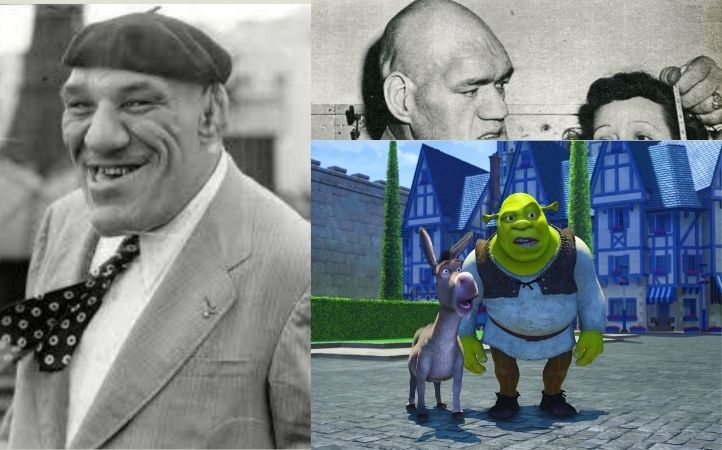Explore the life of Maurice Tillet, ‘The French Angel,’ the wrestler with acromegaly rumored to inspire Shrek. Discover his story and the uncanny resemblance.
Table of Contents
- 1. Was Shrek Inspired by a Real Person? 🤔 The Maurice Tillet Connection
- 2. Who Was Maurice Tillet? 😇 The French Angel’s Life Story
- 2.1 Early Life & Acromegaly: How Maurice Tillet’s Appearance Changed 🧬
- 2.2 From Lawyer to Wrestler: Maurice Tillet’s Unexpected Career Path 🤼♂️
- 2.3 Beyond the Ring: How Many Languages Did Maurice Tillet Speak? 🧠
- 3. Maurice Tillet’s Wrestling Reign: Was He Strong? 💪
- 3.1 The French Angel’s Unstoppable Streak: How Maurice Tillet Dominated the Ring 🏆
- 3.2 Power & Presence: Maurice Tillet’s Unforgettable Impact 🌟
- 4. Shrek’s Origins: From Book to Beloved Ogre 📚
- 4.1 Where Did the Name “Shrek” Come From? 📖
- 4.2 DreamWorks’ Journey: How Shrek Came to Life on Screen 🎬
- 5. The Striking Resemblance: Maurice Tillet & Shrek’s Visual Link 💚
- 5.1 Uncanny Similarities: Why Fans See Shrek in Maurice Tillet 📸
- 5.2 The Louis Linck Busts: A Tangible Connection to Shrek? 🗿
- 5.3 DreamWorks’ Stance: Has Shrek’s Inspiration Been Confirmed? 🤫
- 6. Maurice Tillet’s Personal Legacy: Beyond the Ring & Screen 🕊️
- 6.1 Did Maurice Tillet Marry Olga? Debunking the Rumors 💍
- 6.2 A Friendship Beyond Death: Where is Maurice Tillet Buried? ⚰️
- 7. Maurice Tillet’s Lasting Impact: The Real-Life Shrek? ✨
- 7.1 📚 Works Cited
Was Shrek Inspired by a Real Person? 🤔 The Maurice Tillet Connection
You know Shrek, the lovable green ogre from DreamWorks Animation, right? He’s been a cultural icon since 2001. But have you ever wondered if his unique look was inspired by a real person? This fascinating theory has captivated fans for years, adding a mysterious depth to the character’s origins.
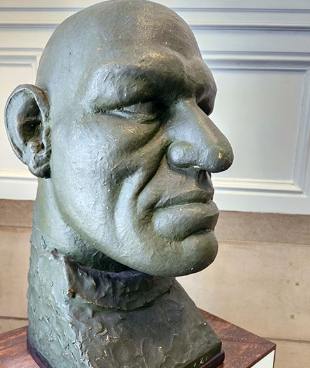
At the heart of this popular culture theory is Maurice Tillet, a Russian-born French professional wrestler, often called “The French Angel” by his fans. In this report, I’ll dive into Tillet’s extraordinary life, his challenges, his remarkable career, and the striking similarities that led to the widespread belief he inspired Shrek. We’ll explore the facts, the rumors, and the profound human story behind this legend.
It’s amazing how “eagle-eyed fans” immediately noticed the resemblance between Shrek and Maurice Tillet, even without official confirmation from DreamWorks. This shows how powerful visual cues can be in shaping popular narratives.
It suggests that a compelling physical likeness can become a widely accepted “truth” in the public consciousness, adding significantly to a fictional character’s mystique and perceived real-world connections. It really highlights how audiences interpret media, sometimes creating backstories not explicitly intended by the creators.
Stories about Maurice Tillet, sometimes called “The World’s Ugliest Wrestler,” and how he was “judged for his appearance, with people widely believing the relatively kind-hearted man was actually a ‘monster’,” directly mirror Shrek’s initial portrayal as a feared ogre. Shrek, despite his intimidating exterior, has a deep kindness within. This thematic echo, whether intentional or coincidental, adds profound meaning to the Shrek character, implying a core message about overcoming prejudice based on appearance. The popular rumor of Tillet’s inspiration humanizes both the historical figure facing societal judgments and the fictional character, transforming a physical anomaly into a powerful point of connection and empathy.
Who Was Maurice Tillet? 😇 The French Angel’s Life Story
Early Life & Acromegaly: How Maurice Tillet’s Appearance Changed 🧬
Maurice Tillet was born on October 23, 1903, in the Ural region of Russia, to French parents. His mother was a teacher, and his father, a railroad engineer, passed away when Maurice was young. As a child, Tillet’s facial features were described as delicate, and his mother even nicknamed him “Angel.” This was a stark contrast to the appearance he would later develop.
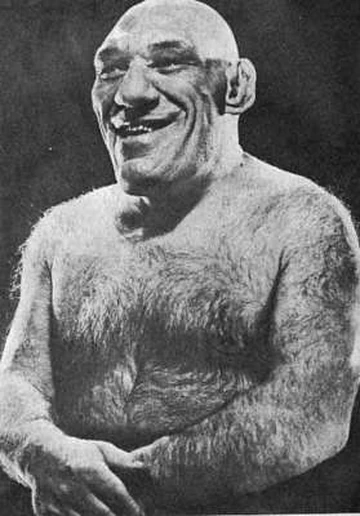
In 1917, when he was 14, Tillet and his mother fled the Russian Revolution and settled in Reims, France. A pivotal moment in his life came with his diagnosis of acromegaly. Some sources say he was 17 , while others state he was 20. This condition is usually caused by a benign tumor on the pituitary gland, leading to excessive growth hormone production. This hormonal disorder caused his bones to thicken and swell, drastically altering his facial and body structure, giving him a truly unique and unforgettable look.
From Lawyer to Wrestler: Maurice Tillet’s Unexpected Career Path 🤼♂️
Before his condition fully manifested, Maurice had intellectual aspirations, especially in law. He successfully earned a law degree from the University of Toulouse. However, he felt his changing facial features and deep voice would hinder his success in the legal profession, so he sought alternative career paths. He served five years in the French Navy’s submarine service and also ventured into other fields, including acting in French films and playing rugby successfully.
His entry into professional wrestling came after a fateful meeting with Lithuanian professional wrestler Karl Pojello in Singapore in February 1937. Pojello recognized Tillet’s distinctive physique and convinced him to pursue a wrestling career. Tillet and Pojello then moved to Paris for training, and Tillet wrestled in France and England for two years until World War II forced them to move to the United States in 1939.
Maurice Tillet’s acromegaly, while a personal challenge, directly steered him away from his initial goal of becoming a lawyer. The very features he thought would impede a legal career, like his “facial features and intense voice,” paradoxically became invaluable assets in the theatrical world of professional wrestling, drawing huge crowds. This really shows how a perceived disadvantage or physical difference can transform into a unique selling point in certain contexts, pushing an individual to adapt, reinvent themselves, and ultimately discover unexpected talents and opportunities. It highlights Tillet’s profound adaptability and resilience in a life fundamentally altered by his condition.
Beyond the Ring: How Many Languages Did Maurice Tillet Speak? 🧠
Beyond his impressive physical presence, Maurice Tillet possessed significant intellect and linguistic talent. It’s widely believed that he could speak at least 14 languages. His mother being a language teacher might have played a significant role in the development of his multilingual abilities. Adding to his intellectual profile, Tillet was also noted for his brilliant chess-playing skills, revealing a sharp and strategic mind beneath his formidable appearance.
Tillet was known for his “unique and unforgettable appearance” and was even controversially dubbed “The World’s Ugliest Wrestler.” Yet, beneath this formidable exterior lay a highly educated individual with a law degree, proficiency in 14 languages, and a talent for chess. This sharp contrast between his outward appearance—which captivated audiences for its novelty—and his deep intellectual capabilities highlights the tendency to make judgments based solely on physical attributes. It often shows how profound inner qualities and accomplishments can be overlooked. This adds a layer of poignancy to Tillet’s biography, portraying him as a complex figure, often perceived only by his physical difference, rather than his keen and cultured mind.
Here’s a quick look at some key facts about Maurice Tillet’s life:
| Feature | Detail | Source |
| Birth Date | October 23, 1903 (some sources say April 23, 1903) | |
| Age at Diagnosis | 17 (some sources say 20) | |
| Condition | Acromegaly | |
| Early Career Goal | Lawyer | |
| Notable Talents | Spoke at least 14 languages, played chess | |
| Wrestling Debut | 1937 | |
| Key Wrestling Achievements | AWA World Heavyweight Champion (2 times), 19-month undefeated streak (some sources say 2 years) | |
| Death Date | September 4, 1954 | |
| Cause of Death | Heart attack due to acromegaly | |
| Burial Place | Lithuanian National Cemetery, Justice, Illinois, USA |
Maurice Tillet’s Wrestling Reign: Was He Strong? 💪
The French Angel’s Unstoppable Streak: How Maurice Tillet Dominated the Ring 🏆
Upon arriving in the United States, specifically Boston, Maurice Tillet quickly established himself as a major box office draw and a dominant competitor. His manager, Paul Bowser, often called “the Vince McMahon of his era,” recognized Tillet’s unique appeal and consistently featured him as the main event. His childhood nickname evolved, and “The French Angel” became his indelible ring name, perfectly reflecting both his origins and his early innocent appearance.
Tillet achieved an astonishing nineteen-month undefeated streak , with one source even extending this impressive run to two years. This success earned him the AWA World Heavyweight Championship, a title he held from May 1940 to May 1942, briefly regaining the Boston-based title in 1944. He also secured the World Heavyweight Championship in Montreal. His distinctive appearance was a primary draw for crowds, attracting spectators eager to see this “unique man.”
Tillet’s immense popularity even led to the emergence of numerous “Angel” imitators, some of whom, like Phil Olafsson (the Swedish Angel), also suffered from acromegaly. This proliferation of “Angels” further solidified Tillet’s status as a groundbreaking wrestling phenomenon.
Maurice Tillet’s acromegaly made him “unique and unforgettable” and undoubtedly drew crowds as a “large attraction.” Yet, that same uniqueness also led to him being labeled “The World’s Ugliest Wrestler.” This paradox shows how a prominent physical trait in entertainment, while providing a significant competitive edge and drawing immense public interest, can also lead to objectification, sensationalism, and demeaning labels. It suggests a complex and often challenging dynamic between public admiration and an individual’s personal dignity when their appearance becomes a central part of their public identity.
Power & Presence: Maurice Tillet’s Unforgettable Impact 🌟
While specific measurements of Maurice Tillet’s physical strength aren’t detailed in the provided information, his large physique was clearly described as “perfect for a wrestler.” He was praised as a “very talented wrestler and a great competitor,” with his “capabilities unmatched” in the ring. His consistent ability to defeat opponents and maintain a long undefeated streak undeniably implies significant physical strength, exceptional wrestling prowess, and strategic skill. Despite its relatively short duration, Tillet’s wrestling career is widely considered “one of the most acclaimed wrestling careers ever.”
By 1944-1945, Tillet’s health began to decline, with his acromegaly starting to affect his overall well-being. This led to the end of his “unstoppable” promotional advertisements. He continued to wrestle until 1953, with his last known match being a pre-arranged loss to Bert Assirati in Singapore.
The rapid emergence of numerous “Angel imitators” , some also suffering from acromegaly, clearly highlights the tendency to commercially capitalize on Maurice Tillet’s unique physical attributes and success. This points to a broader historical pattern in the entertainment industry where individuals with unusual physical characteristics were often exploited or sensationalized, from circus sideshows to professional wrestling.
Tillet’s groundbreaking success inadvertently paved the way for others to leverage similar conditions for their own careers, even if they couldn’t match his singular skill and captivating presence. It underscores the industry’s propensity to replicate successful formulas, even those based on physical anomalies.
Shrek’s Origins: From Book to Beloved Ogre 📚
Where Did the Name “Shrek” Come From? 📖
The character of Shrek is a fictional ogre created by American author William Steig. He first appeared in Steig’s children’s book of the same name. The name “Shrek” itself has a fascinating linguistic origin. It’s a romanization of the Yiddish word “שרעק” ( shrek) or “שרעקלעך” (shreklekh), which is directly related to the German word “Schreck,” both meaning “fear” or “fright.” This etymological root subtly reinforces the character’s initial portrayal as a frightening and intimidating figure, an perception that gradually shifts as his true, kind-hearted nature is revealed.
DreamWorks’ Journey: How Shrek Came to Life on Screen 🎬
Shrek’s transformation from a children’s book character to a beloved animated film hero was a long process. Steven Spielberg initially acquired the book rights in 1991. Prominent actors like Bill Murray and Nicolas Cage were considered early on for Shrek’s voice, with Cage ultimately declining the role. Tragically, Chris Farley recorded a significant portion (an estimated 80-90%) of Shrek’s dialogue before his untimely death in December 1997, leading to a costly scrapping of much of the initial development.
In August 1998, Mike Myers was recast as Shrek. After seeing a rough cut of the film, Myers made the significant decision to re-record all his lines in a Scottish accent. This choice was inspired by his mother’s storytelling style and, more importantly, aimed to convey a “class struggle” between Shrek, whom Myers saw as a working-class character, and the English-accented villain, Lord Farquaad. This decision, though costing DreamWorks an additional $4 million in re-animation, was widely credited with profoundly improving the film. Early concept sketches for Shrek’s dwelling evolved from a garbage dump near a human village to his iconic swamp.
Mike Myers’ decision to re-record Shrek’s dialogue with a Scottish accent, explicitly linking it to a “class struggle,” shows how a seemingly small creative choice can fundamentally reshape a character’s identity and thematic depth. This wasn’t just an aesthetic preference; it was a deliberate narrative decision, adding layers of social commentary and relatability to an otherwise fantastical ogre. It highlights the profound impact of voice acting on character development, demonstrating how a voice can imbue a character with specific cultural or socio-economic undertones, making them more resonant and complex for audiences.
The detailed accounts of Shrek’s film development , meticulously covering voice casting, script rewrites, and visual design, do not explicitly mention Maurice Tillet as an inspiration. This stands in stark contrast to the widespread public belief that Tillet was indeed the muse. This discrepancy suggests a significant disconnect between the documented intentions of the creators and the audience’s interpretation and construction of a character’s origins.
It implies that once a cultural product is released, its meaning and perceived inspirations can be shaped by external resemblances and audience-driven narratives, independent of the original creative team’s explicit plans. This phenomenon is common in popular culture, where fan theories gain significant, almost canonical, traction.
The Striking Resemblance: Maurice Tillet & Shrek’s Visual Link 💚
Uncanny Similarities: Why Fans See Shrek in Maurice Tillet 📸
The most compelling evidence supporting the theory that Maurice Tillet inspired Shrek lies in the striking and undeniable physical resemblance between the two. Photographs of Tillet, particularly after the onset of his acromegaly, reveal facial features and a robust build that are remarkably similar to the beloved animated ogre. Upon Shrek’s cinematic release in 2001, “eagle-eyed fans immediately noticed the similarities” , drawing direct comparisons between the animated character and the man sometimes referred to as “The Ugliest Man in Wrestling.” This theory has gained momentum over the years, with many observers describing the two as “virtually identical.”
Beyond just physical appearance, there’s also a thematic parallel: Tillet, despite being a kind-hearted individual, was often “judged and perceived as a ‘monster'” due to his appearance. This narrative closely aligns with Shrek’s story, where his ogre appearance initially causes others to fear him, while concealing his gentle nature.
The Louis Linck Busts: A Tangible Connection to Shrek? 🗿
Further strengthening the inspiration theory are the plaster busts of Maurice Tillet created by Chicago sculptor Louis Linck in 1950. These busts served two primary purposes: to commemorate Tillet’s distinguished wrestling career and to medically document how acromegaly affects the human body. Tillet collaborated with Linck on these sculptures just a few years before his death, making them authentic representations of his appearance in later life. One of these significant busts is preserved at the International Museum of Surgical Science in Chicago, standing as a testament to Tillet’s courage and resilience in the face of his condition. Crucially, these busts, along with various images of Tillet, are “widely and credibly credited with being the inspiration” for the design of the Shrek character, providing a tangible visual link.
The plaster busts created by Louis Linck , while initially made to commemorate Tillet’s career and document his medical condition, have inadvertently become significant “tangible connections” in the Shrek inspiration theory. This shows how historical artifacts, initially created for entirely different purposes, can later gain new cultural significance and serve to perpetuate and legitimize popular narratives, especially when official confirmation is absent. The busts function as compelling visual evidence that significantly reinforces the perceived link between Tillet and Shrek in the public imagination.
DreamWorks’ Stance: Has Shrek’s Inspiration Been Confirmed? 🤫
Despite the striking visual evidence and widespread public belief, DreamWorks Animation has maintained a position of neither officially confirming nor denying whether Maurice Tillet served as a direct inspiration for the Shrek character. This deliberate lack of official statement allows the connection to remain in the realm of popular rumor and speculation, arguably enhancing the character’s mystique and fostering ongoing public discussion.
DreamWorks’ consistent stance of “neither confirmed nor denied” regarding Tillet’s inspiration isn’t just a passive response; it’s potentially a strategic one. By avoiding confirmation, they sidestep potential legal or ethical complexities (e.g., intellectual property rights, issues of portrayal).
By not issuing a denial, they allow the popular rumor to persist, which arguably enhances the character’s mystique, generates continuous discussion, and fosters deeper fan engagement without direct marketing effort. This implies that, in the entertainment industry, calculated silence can sometimes be the most effective response to a persistent fan theory, allowing the audience to actively construct the narrative and deepen their connection to the property.
Here’s a table to visually reinforce the key similarities between Maurice Tillet and Shrek:
| Category | Maurice Tillet | Shrek |
| Physical Appearance | Prominent facial features due to acromegaly, large and robust build, often described as “unforgettable.” | Green-skinned, large, physically intimidating ogre with prominent facial features. |
| Perceived vs. True Character | Often judged as “ugly” or a “monster” due to appearance, but described as kind-hearted, intelligent, and resilient. | Initially feared and misunderstood as a grumpy, solitary ogre, but revealed to be kind-hearted and loyal. |
| Cultural Impact/Legacy | “The French Angel,” unique wrestling phenomenon, subject of commemorative busts. | Beloved animated character, cultural icon. |
Maurice Tillet’s Personal Legacy: Beyond the Ring & Screen 🕊️
Did Maurice Tillet Marry Olga? Debunking the Rumors 💍
Numerous social media posts frequently circulate a photo showing Maurice Tillet playfully “wrestling” with a young woman, often misidentifying her as his wife, “Olga.” Some of these posts even claim the woman in the photo is the famous model Dorian Leigh. However, a thorough review of historical and biographical information concerning Maurice Tillet reveals no consistent concrete evidence that he was ever married.
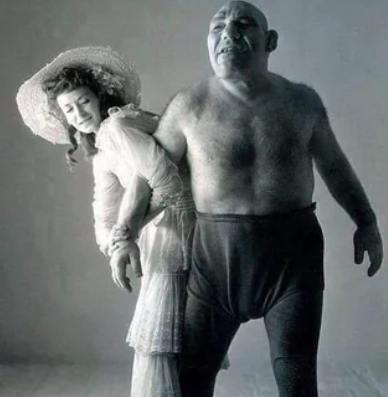
Notably, his 1944 petition for American citizenship explicitly stated he was single, further undermining the “Olga” narrative. This suggests the widespread “Olga” narrative is likely an unfounded social media rumor or a persistent misidentification stemming from a casual photo of Tillet with a female acquaintance or model that has been misinterpreted over time.
The persistent and widespread social media claim that Maurice Tillet was married to “Olga” , despite the absence of any historical documentation to corroborate it , vividly illustrates how easily and enduringly misinformation can spread in the digital age. This phenomenon highlights the critical issue of the distinction between factual historical narratives and popular, yet unverified, accounts, especially when information is primarily anecdotal or visually driven on social media platforms. It implies an increased need for critical source evaluation, as such platforms can inadvertently become engines for historical myth-making.
A Friendship Beyond Death: Where is Maurice Tillet Buried? ⚰️
Maurice Tillet’s health progressively declined in his later years as a result of his acromegaly, which led to an enlarged heart. On September 4, 1954, at the age of 50 , he passed away from a heart attack. In a profoundly tragic turn of events, Tillet’s death occurred on the very same day as his close friend, mentor, trainer, and manager, Karl Pojello, who died from lung cancer. Upon receiving the news of Pojello’s death, Maurice Tillet suffered a fatal heart attack and was rushed to Cook County Hospital, where he succumbed.
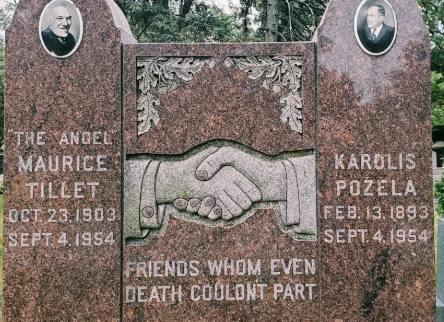
As a poignant testament to their deep and enduring bond, Maurice Tillet and Karl Pojello are buried together at the Lithuanian National Cemetery in Justice, Illinois. Their shared tombstone bears a touching inscription: ”
Friends Whom Even Death Couldn’t Part,” and uniquely features a likeness of Tillet’s face. Maurice Tillet’s death from a heart attack on the same day he received news of his lifelong friend Karl Pojello’s passing represents a powerful, yet tragic, cause-and-effect relationship. It suggests an extraordinarily deep emotional and psychological bond between the two men, so profound that the shock and grief of one loss directly triggered the death of the other.
This goes beyond mere friendship, perhaps indicating a deep mutual dependency, intensified by Tillet’s unique challenges and Pojello’s multifaceted role as his discoverer, trainer, manager, and constant companion. It serves as a poignant example of the critical role of close human connection and emotional support, especially for individuals who might face societal isolation due to their appearance or condition. The joint burial and the inscription “Friends Whom Even Death Couldn’t Part” on their tombstone further solidify the depth of this exceptional bond.
Maurice Tillet’s Lasting Impact: The Real-Life Shrek? ✨
“The French Angel,” Maurice Tillet, lived a life filled with extraordinary resilience, intellectual depth, and remarkable achievements. He transformed the challenges of his acromegaly into a unique strength and a source of public fascination, building a celebrated career in professional wrestling. His journey from aspiring lawyer to world champion, coupled with his multilingualism and sharp intellect, paints a portrait of a man who consistently defied societal expectations and overcame personal adversity.
While DreamWorks Animation has maintained a deliberate silence on the matter, the striking visual parallels between Tillet and Shrek, further emphasized by the historical Louis Linck busts, have solidified his place in popular culture as the “real-life Shrek.” This enduring rumor is a testament to the power of visual storytelling and the inherent human desire to find real-world connections and compelling backstories for beloved fictional characters.
Tillet’s story, including the touching narrative of his profound friendship with Karl Pojello, stands as powerful evidence of the strength of the human spirit, the complex impact of physical difference, and the lasting legacy of an individual who, despite being labeled “ugly,” represented a profound and unforgettable presence both inside and outside the wrestling ring.
Maurice Tillet’s life story has become inextricably linked with the character of Shrek, whether officially acknowledged as an inspiration or not. This suggests a symbiotic relationship where the historical figure (Tillet) lends a sense of “authenticity,” depth, and a compelling human narrative to the fictional character (Shrek), while the fictional character (Shrek) grants a form of “immortality” and renewed relevance to the historical figure (Tillet) for new generations.
This dynamic enriches both narratives, making Tillet more widely recognized by contemporary audiences and providing Shrek with an intriguing, albeit unofficial, origin story that deeply resonates with themes of universal acceptance, inner beauty, and overcoming prejudice.
The information explicitly states that “through the internet, Maurice will forever be remembered as the man who inspired everybody’s favorite ogre, Shrek.” This highlights the profound transformative power the internet holds in unearthing, disseminating, and popularizing historical connections, including those lacking official confirmation.
The internet acts as a vast, democratized archive and a collective myth-making engine, allowing previously obscure historical figures to gain new prominence and popular fan theories to become widely accepted “truths.” This implies that the digital age has fundamentally reshaped how historical figures are remembered, how cultural narratives are constructed, and how information (both factual and speculative) is perpetuated across generations.
📚 Works Cited
- “The French Angel.” Wikipedia, Wikimedia Foundation, n.d., https://en.wikipedia.org/wiki/The_French_Angel. Accessed 31 July 2025.
- “Karl Pojello.” Wikipedia, Wikimedia Foundation, n.d., https://en.wikipedia.org/wiki/Karl_Pojello. Accessed 31 July 2025.
- “Maurice Tillet, ‘French Angel’ Wrestler And ‘Real-Life Shrek’.” All That’s Interesting, n.d., https://allthatsinteresting.com/maurice-tillet. Accessed 31 July 2025.
- “Maurice Tillet, The French Angel.” Athlon Outdoors, 5 Aug. 2024, https://athlonoutdoors.com/article/maurice-tillet-the-french-angel/. Accessed 31 July 2025.
- “Picture of Maurice Tillet and Olga. Shrek was actually based off him.” Reddit, r/pics, n.d., https://www.reddit.com/r/pics/comments/d51ujd/picture_of_maurice_tillet_and_olga_shrek_was/. Accessed 31 July 2025.
- “Shrek (character).” Wikipedia, Wikimedia Foundation, 30 July 2025, https://en.wikipedia.org/wiki/Shrek_(character. Accessed 31 July 2025.
- “Shrek’s Story: He Was Inspired by a Real Person.” Bright Side, n.d., https://brightside.me/articles/shreks-story-he-was-inspired-by-a-real-person-812976/. Accessed 31 July 2025.
- “Who Was The French Angel?” Chicago Magazine, n.d., https://www.chicagomag.com/arts-culture/who-was-the-french-angel/. Accessed 31 July 2025.
- “Who was Maurice Tillet’s mysterious wife? (If he had one.)” Reddit, r/AskHistorians, n.d., https://www.reddit.com/r/AskHistorians/comments/1hik4bo/who_was_maurice_tillets_mysterious_wife_if_he_had/. Accessed 31 July 2025.
- Complex. “Is Maurice Tillet the Man That Inspired the Beloved Shrek?” YouTube, n.d., https://www.youtube.com/shorts/OjMkLC2t4-U. Accessed 31 July 2025.
- Jenness, Kirik. “Meet the pro wrestler who was the inspiration for Shrek.” Mixed Martial Arts, 16 May 2023, https://mixedmartialarts.com/wtf/meet-pro-wrestler-inspiration-shrek/. Accessed 31 July 2025.
- Costa Rica Reptiles – A Guide to Lizards, Snakes, and Crocodilians
- Costa Rica Frogs – A Guide to the Jewel-like Amphibians
- Costa Rica Wildlife – A Guide to Its Most Fascinating Mammals
- What is Alavism: Suuni or Shia?
- What Was Wittgenstein’s Main Idea: Ideas, Legacy, and Key Questions
- The Secret to Jordan Peterson’s Debate Strategy: It’s All a Word Game
- The Banshees of Inisherin: Thrownness, Pride, Anxiety, and Nothingness
